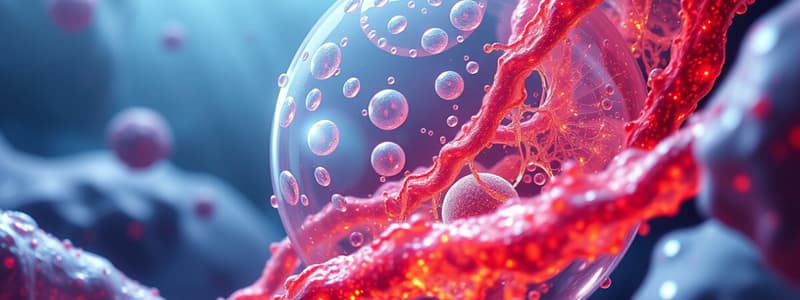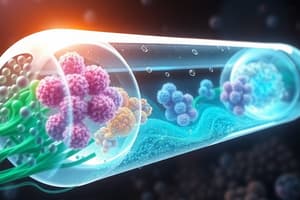Podcast
Questions and Answers
What does the term 'hydrophobic tail' refer to?
What does the term 'hydrophobic tail' refer to?
- Water loving
- Water fearing (correct)
- A protein with a carbohydrate attached
- A lipid with attached carbohydrates
What does the term 'hydrophilic head' refer to?
What does the term 'hydrophilic head' refer to?
- Water fearing
- A double layer of phospholipids
- Water loving (correct)
- A protein loosely bound to a membrane
What is the function of a channel protein?
What is the function of a channel protein?
Allows substances to move through the membrane.
What is a glycolipid?
What is a glycolipid?
What is cholesterol's role in cell membranes?
What is cholesterol's role in cell membranes?
What is a phospholipid bilayer?
What is a phospholipid bilayer?
What is a glycoprotein?
What is a glycoprotein?
What is a peripheral protein?
What is a peripheral protein?
What does a carbohydrate chain do?
What does a carbohydrate chain do?
Flashcards
Hydrophobic Tail
Hydrophobic Tail
The 'water-fearing' part of a molecule, repelled by water.
Hydrophilic Head
Hydrophilic Head
The 'water-loving' part of a molecule, attracted to water.
Channel Protein
Channel Protein
A protein that creates a tunnel to facilitate the movement of specific substances across a cell membrane.
Glycolipid
Glycolipid
Signup and view all the flashcards
Cholesterol in Membranes
Cholesterol in Membranes
Signup and view all the flashcards
Phospholipid Bilayer
Phospholipid Bilayer
Signup and view all the flashcards
Glycoprotein
Glycoprotein
Signup and view all the flashcards
Peripheral Protein
Peripheral Protein
Signup and view all the flashcards
Carbohydrate Chain
Carbohydrate Chain
Signup and view all the flashcards
Study Notes
Cell Membrane Components
- Hydrophobic Tail: Refers to the water-fearing part of a phospholipid, which avoids water and interacts with other hydrophobic substances.
- Hydrophilic Head: Denotes the water-loving part of a phospholipid, which attracts water molecules and forms the outer layer of the membrane.
Membrane Proteins
- Channel Protein (Integral Protein): Facilitates the movement of specific substances across the cell membrane, aiding in transport and communication.
- Peripheral Protein: A protein that is not embedded in the lipid bilayer but instead is loosely attached to the membrane's surface, playing roles in signaling and structural support.
Lipid Structures
- Glycolipid: A lipid molecule that has carbohydrate chains attached, contributing to cell recognition and signaling.
- Cholesterol: A crucial lipid in the cell membrane that maintains membrane fluidity and stability, especially in varying temperatures.
- Phospholipid Bilayer: Composed of two layers of phospholipids, this structure forms the basic framework of plasma and organelle membranes, providing a barrier between the cell's interior and external environment.
Identification and Signaling
- Glycoprotein: A protein that has carbohydrate chains attached, involved in cell recognition and communication.
- Carbohydrate Chain: Structures attached to proteins or lipids that function in cell identification, playing key roles in immune response and cell interactions.
Studying That Suits You
Use AI to generate personalized quizzes and flashcards to suit your learning preferences.




